- Joined
- Sep 22, 2019
- Messages
- 1,034
EditAdjustable stop for my press brake
Question...
What are the proper terms for the upper movable part and the lower, fixed "V" part??
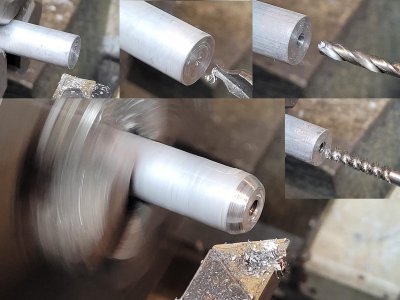
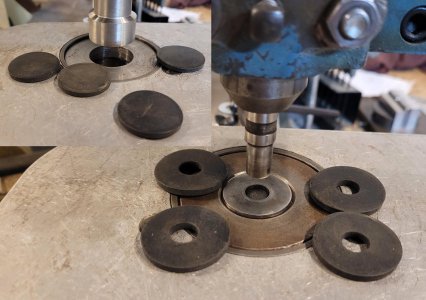
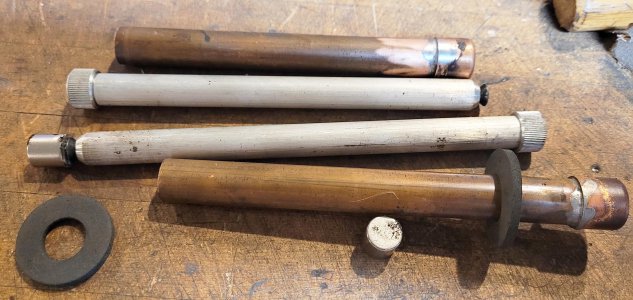
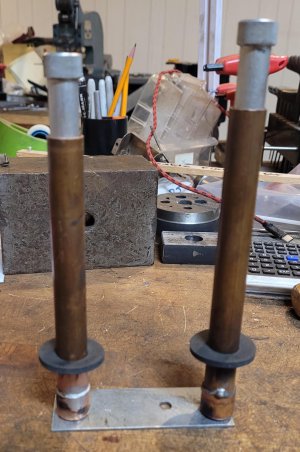
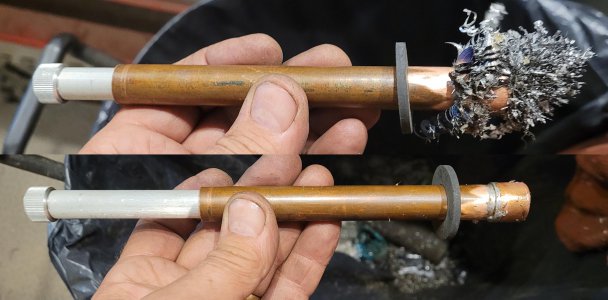
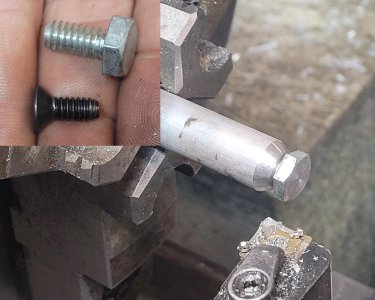
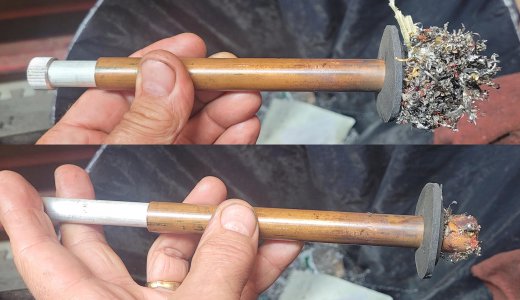
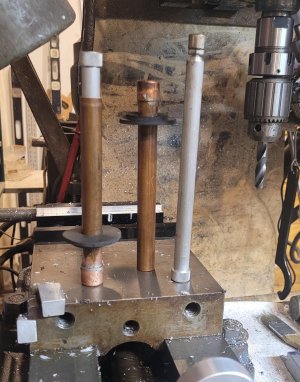
I took a big pen (one of the advertising pens ) and did something similar. it's plastic and has been holding for since 2014 so I don't need another right now. Mine wasn't as big a magnet. I think it was 1/2 x 1/4.. your's must have some good pull.POTD was making a couple of chip picker uppers. John Herrmann (@hman) and I swapped some stuff years ago; he sent me a brass-tube chip magnet. John’s picker upper is a nice design; non-ferrous tube with an internal rare-earth magnet. The magnet normally sets at the bottom of the tube and is lifted with a flat heat steel screw with a soldered-on pull-wire. A rubber washer slips on the tube and acts as a stop for the chips as the magnet is retracted. In use, dip the end of the tool in ferrous chips which stick to the tube. Head for the trash can and pull back on the handle which retracts the magnet. The chips hit the rubber washer and fall into the trash. And full disclosure, John’s chip magnet is “someplace” in my shop. I think the line goes something like “Since it’ll turn up in the last place you’d think to look, just start there. . .”
I used ½” copper tubing for these “quicker picker uppers”. Soldered caps on the ends which I didn’t show. The rare earth magnets were ones on hand, ½” diameter about 3/4” long. I used ½” aluminum stock for the pull rod; would have preferred something smaller but that’s the smallest aluminum I have on hand.
Chucked up the aluminum, faced, center drilled, tap drilled and tapped a 10-24 hole. A flat head steel screw would go here. In use, the magnet “sticks” to the screw head so it travels with the rod when the latter is retracted. Parted the rod, flipped, and repeated the facing, center drilling, tap drilling, tapping for a knob. The knobs were in my junk drawer.
View attachment 454537
The rubber washers were punched from 1/8” rubber. Did this work on the Roper Whitney 218 punch press. Used a 1 ¼” punch for the washer OD. The ½” copper tubing had an OD of 5/8” while my punches go from 1/2” to 5/8”. I wanted a tight fit, and went with the ½” punch. I didn’t show it, but used a sanding drum in a cordless drill to open up the ID so the rubber washer had a “Goldilocks” fit on the copper tubing: Not too loose, not too tight, just right.
View attachment 454538
And full disclosure, the photos were of my first go around, not of the final product though they are very similar. I ran into a couple of problems. First, the rubber washer OD was a bit too small. It can pick up a huge wad of swarf, bigger than the OD of the washer. When I retracted the magnet, some chips hopped over the washer and rode up the copper tube. I made larger rubber washers with a 1 ¾” punch; they work much better. There’s an easy work around when chips jump the washer; wrap a rag around the tubing above the washer when pulling the plunger.
Here are the parts for version 1. Lower aluminum rod has a magnet stuck on the 10-24 screw head
View attachment 454557
View attachment 454558
Dunk in the swarf, and pull the plunger to dump the chips
View attachment 454559
The other problem was the size of the magnet relative to the amount of iron in the 10-24 screw used in the plunger. I’m not a magnetic engineer, so theorizing a bit here. Problem was the magnet could hold a huge wad of chips at the end of the tube. When I’d pull the plunger, the magnet stayed stuck at the bottom of the tube with the wad of chips and separated from the 10-24 screw head. My assumption is the magnetic coupling between the magnet and chips through the copper was greater than the magnetic coupling between the magnet and 10-24 screw head. The 10-24 screws were replaced with short ¼”-20 bolts which worked a lot better. I could still pick up a huge wad of chips and had no problems with the magnet pulling off the plunger screw. And please wish me luck finding John’s original “quicker picker upper!”
Overcame the magnet peeling off the screw by changing to a 1/4"-20 bolt instead of a 10-24 screw. More iron means more magnetic "grip". I faced the bolt heads to give the magnets a nice flat surface to stick to.
View attachment 454560
Larger rubber washer did a much better job keeping chips from jumping over the washer
View attachment 454561
View attachment 454562
Thanks for looking, Bruce
It does, on the verge of too much. If I go flat on a surface it'll stick pretty tightly. It works best to drag it on edge.Mine wasn't as big a magnet. I think it was 1/2 x 1/4.. your's must have some good pull.
 One friggin BIG LOG to cut up and split . The last big log has put me in the wound center since Memorial Day weekend . Had a log fall on my shin . Put a quarter size hole in my shin a half inch deep .
One friggin BIG LOG to cut up and split . The last big log has put me in the wound center since Memorial Day weekend . Had a log fall on my shin . Put a quarter size hole in my shin a half inch deep . I used a length of #12 copper wire for the pull handle on my original swarf picker. Formed a ~1" loop in the upper end, and used a dab of solder to hold the loop closed.POTD was making a couple of chip picker uppers. John Herrmann (@hman) and I swapped some stuff years ago; he sent me a brass-tube chip magnet. John’s picker upper is a nice design; non-ferrous tube with an internal rare-earth magnet. The magnet normally sets at the bottom of the tube and is lifted with a flat heat steel screw with a soldered-on pull-wire. A rubber washer slips on the tube and acts as a stop for the chips as the magnet is retracted. In use, dip the end of the tool in ferrous chips which stick to the tube. Head for the trash can and pull back on the handle which retracts the magnet. The chips hit the rubber washer and fall into the trash. And full disclosure, John’s chip magnet is “someplace” in my shop. I think the line goes something like “Since it’ll turn up in the last place you’d think to look, just start there. . .”
I used ½” copper tubing for these “quicker picker uppers”. Soldered caps on the ends which I didn’t show. The rare earth magnets were ones on hand, ½” diameter about 3/4” long. I used ½” aluminum stock for the pull rod; would have preferred something smaller but that’s the smallest aluminum I have on hand.
Chucked up the aluminum, faced, center drilled, tap drilled and tapped a 10-24 hole. A flat head steel screw would go here. In use, the magnet “sticks” to the screw head so it travels with the rod when the latter is retracted. Parted the rod, flipped, and repeated the facing, center drilling, tap drilling, tapping for a knob. The knobs were in my junk drawer.
View attachment 454537
The rubber washers were punched from 1/8” rubber. Did this work on the Roper Whitney 218 punch press. Used a 1 ¼” punch for the washer OD. The ½” copper tubing had an OD of 5/8” while my punches go from 1/2” to 5/8”. I wanted a tight fit, and went with the ½” punch. I didn’t show it, but used a sanding drum in a cordless drill to open up the ID so the rubber washer had a “Goldilocks” fit on the copper tubing: Not too loose, not too tight, just right.
View attachment 454538
And full disclosure, the photos were of my first go around, not of the final product though they are very similar. I ran into a couple of problems. First, the rubber washer OD was a bit too small. It can pick up a huge wad of swarf, bigger than the OD of the washer. When I retracted the magnet, some chips hopped over the washer and rode up the copper tube. I made larger rubber washers with a 1 ¾” punch; they work much better. There’s an easy work around when chips jump the washer; wrap a rag around the tubing above the washer when pulling the plunger.
Here are the parts for version 1. Lower aluminum rod has a magnet stuck on the 10-24 screw head
View attachment 454557
View attachment 454558
Dunk in the swarf, and pull the plunger to dump the chips
View attachment 454559
The other problem was the size of the magnet relative to the amount of iron in the 10-24 screw used in the plunger. I’m not a magnetic engineer, so theorizing a bit here. Problem was the magnet could hold a huge wad of chips at the end of the tube. When I’d pull the plunger, the magnet stayed stuck at the bottom of the tube with the wad of chips and separated from the 10-24 screw head. My assumption is the magnetic coupling between the magnet and chips through the copper was greater than the magnetic coupling between the magnet and 10-24 screw head. The 10-24 screws were replaced with short ¼”-20 bolts which worked a lot better. I could still pick up a huge wad of chips and had no problems with the magnet pulling off the plunger screw. And please wish me luck finding John’s original “quicker picker upper!”
Overcame the magnet peeling off the screw by changing to a 1/4"-20 bolt instead of a 10-24 screw. More iron means more magnetic "grip". I faced the bolt heads to give the magnets a nice flat surface to stick to.
View attachment 454560
Larger rubber washer did a much better job keeping chips from jumping over the washer
View attachment 454561
View attachment 454562
Thanks for looking, Bruce
